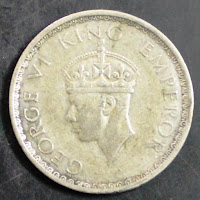1902-1910: King Edward VII
King Edward’s reign was a short reign but it was marked by
the minting of different types of coins for the British colonies of which India
was one. The third farthing was minted for use in Malta. Most of the coins that
were worth less than a farthing were minted for use only in the colonies. The
coins in my collection are mostly made of copper, and they come in the form of
divisions of the Anna. These years apparently saw few silver coins minted.
1911-1936: King George V
King George the fifth’s reign saw the use of silver but then
in 1920 the royal mint used an alloy that contained half silver, till at least
1924. From 1924 onwards, the silver was not used in the coins. A few of the coins in my collection contain
silver as an essential constituent.
1936-1947:King Edward VIII
Strangely enough, coins of this period use George the Fifth’s head although they belong to Edward the eighth’s reign! King Edward the eighth had abdicated from the throne before coins bearing his head could be minted!
1947: Post Independence
Coins minted post-Independence saw the use initially of an
alloy that was slightly heavier than pure aluminium. After the year the coins were made of pure aluminium
for coins in the denomination of five and ten. Coins of the denomination of 25
paisa and above were made of cupro-nickel.
During the Second World War, the copper was considered an
important metal and thus one saw coins that had holes in them, so as to reduce
the amount of copper that went into the making of coins. I have a coin that has
a hole in its middle.


















No comments:
Post a Comment